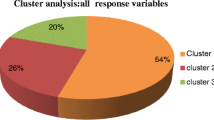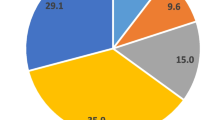Abstract
Background
Ambulatory health care services are a major contributor to the large and inequitable health financing burdens (largely out-of-pocket) faced by households in India. The private sector has a virtual monopoly over ambulatory curative services in rural and urban India. Despite this, there is little knowledge about who these providers are, their numbers, distribution, and activities.
Aim
This study describes the numbers, gender, distribution, and characteristics of private individual ambulatory care providers in Madhya Pradesh (60.4 million people), one of India’s largest provinces. It discusses the suitability of this provider mix to deal with maternal and child health, a major health priority in the province.
Method
A survey enlisting all health care providers was conducted in the 52,117 villages and 394 towns of the province.
Results
There were 14,046 private qualified physicians (12.5% women), 57,684 qualified paramedics (3.4% women), and 89,090 unqualified providers (10% women) providing ambulatory services in individual setups. In addition, 55,393 traditional birth attendants provided home-based intranatal care. The macro organization of these providers in this setting is presented. Given the high levels of maternal and child mortality in the province, excessive reliance is placed on less than competent providers as these present lower access barriers.
Conclusion
Given the public health priorities in this province (maternal and child health), the provider mix is not optimally suited to the populations’ needs. There is a lack of competent qualified care required to deal with the major causes of morbidity and mortality, particularly in rural areas. Access to qualified women providers is low. The lack of a cadre of qualified midwives possibly contributes to some of the high maternal mortality observed in this province.


Similar content being viewed by others
References
Berman P (2000) Organization of ambulatory care provision: a critical determinant of health system performance in developing countries. Bull World Health Organ 78(6):791–802
De Costa A, Diwan V (2007) ‘Where is the public health sector?’ Public and private sector healthcare provision in Madhya Pradesh, India. Health Policy 84(2–3):269–276
De Costa A, Saraf V, Jhalani M, Mahadik VK, Diwan VK (2008) Managing with maps? The development and institutionalization of a map-based health management information system in Madhya Pradesh, India. Scand J Public Health 36(1):99–106
Duggal R (2007) Poverty & health: criticality of public financing. Indian J Med Res 126(4):309–317
Government of India (2005) National health accounts, India 2001–2002. National Health Accounts Cell. Ministry of Health and Family Welfare, New Delhi
Government of Madhya Pradesh (2007) The Fourth Madhya Pradesh human development report. Bhopal
Hanson K, Berman P (1998) Private health care provision in developing countries: a preliminary analysis of levels and composition. Health Policy Plan 13(3):195–211
International Institute for Population Sciences (2007) National Family Health Survey (NFHS-3) 2005–06: India. Volume I. Mumbai, India
Jones G, Schultink W, Babille M (2006) Child survival in India. Indian J Pediatr 73(6):479–487
Kamat VR (2001) Private practitioners and their role in the resurgence of malaria in Mumbai (Bombay) and Navi Mumbai (New Bombay), India: serving the affected or aiding an epidemic. Soc Sci Med 52(6):885–909
Mavalankar D, Vora K, Prakasamma M (2008) Achieving Millennium Development Goal 5: is India serious? Bull World Health Organ 86(4):243–243A
Murray CJL, Lopez AD, Harvard School of Public Health, World Health Organization, World Bank (1996) The global burden of disease: a comprehensive assessment of mortality and disability from diseases, injuries, and risk factors in 1990 and projected to 2020. Harvard School of Public Health on behalf of the World Health Organization and the World Bank, Cambridge, MA; distributed by Harvard University Press
National Sample Survey Organization (2006) Morbidity, health care and conditions of the aged: sixtieth round (January–June 2004). National Sample Survey Organization, New Delhi
Pallikadavath S, Foss M, Stones RW (2004) Antenatal care: provision and inequality in rural north India. Soc Sci Med 59(6):1147–1158
Preker AS, Harding A, Girishankar N (1999) The economics of public and private participation in health care: new insights from institutional economics. The World Bank, Washington DC
Ramachandar L, Pelto PJ (2002) The role of village health nurses in mediating abortions in rural Tamil Nadu, India. Reprod Health Matters 10(19):64–75
Rani M, Bonu S, Harvey S (2008) Differentials in the quality of antenatal care in India. Int J Qual Health Care 20(1):62–71
Registrar General, India (2001–2003) Sample Registration System, New Delhi
Registrar General & Census Commissioner (2001) Census of India
Registrar General & Census Commissioner, Government of India (2006) Sample registration system Bulletin. http://www.censusindia.gov.in/Vital_Statistics/SRS_Bulletins/SRS_Bulletins_links/SRS_Bulletin-October-2006.pdf. Accessed 3 May 2008
TARU (2002) Study on the dynamics and structure of the private health sector in Madhya Pradesh India
Uplekar M, Pathania V, Raviglione M (2001) Private practitioners and public health: weak links in tuberculosis control. Lancet 358(9285):912–916
Vishwanathan H, Rohde J (1990) Diarrhea in rural India: a nationwide survey of mothers and practitioners. Vision Books, New Delhi
Wagstaff A (2000) Socioeconomic inequalities in child mortality: comparisons across nine developing countries. Bull World Health Organ 78(1):19–29
World Health Organization, Health statistics (2006). http://www.who.int/whosis/database/core/core_select_process.cfm. Accessed 22 April 2007
Acknowledgements
The Madhya Pradesh Basic Health Services Project, Bhopal, India and the Swedish Institute, Stockholm
Conflict of interest
The authors confirm that there are no relevant associations that might pose a conflict of interest.
Author information
Authors and Affiliations
Corresponding author
Appendix
Appendix
Indian systems of medicine comprise a number of indigenous systems including ayurveda, unani, homeopathy, siddhi and other systems. Full recognized licenced physician qualifications are awarded by universities in either ayurveda, unani or homeopathy. The Department of Indian Systems of Medicines and Homoeopathy (ISM & H) was set up in Ministry of Health & Family Welfare, Government of India, in March, 1995. The department currectly functions as Department of Ayurveda, Yoga & Naturopathy, Unani, Siddha and Homoeopathy under the Ministry of Health. Details on each of the systems can be found at the official website of the Department of Indian Systems of Medicine at http://indianmedicine.nic.in/.
Rights and permissions
About this article
Cite this article
De Costa, A., Eriksson, B. & Diwan, V.K. Private individual ambulatory health care providers in Madhya Pradesh province, India. J Public Health 17, 235–241 (2009). https://doi.org/10.1007/s10389-008-0245-2
Received:
Accepted:
Published:
Issue Date:
DOI: https://doi.org/10.1007/s10389-008-0245-2




